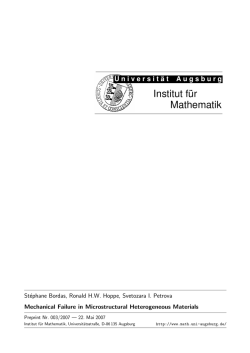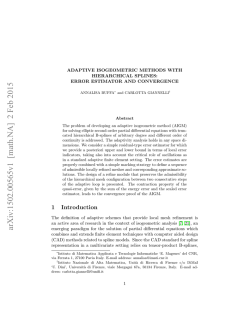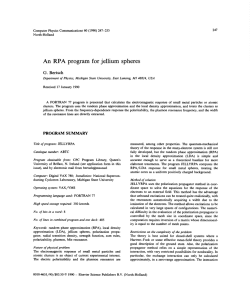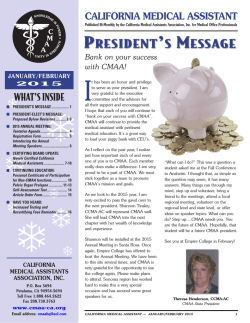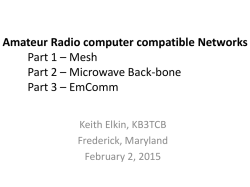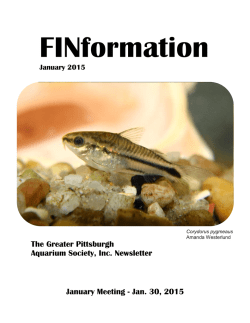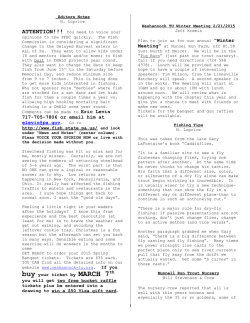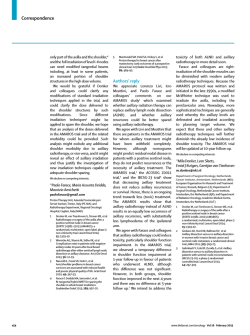
Gill-net selectivity off the Portuguese western coast
Fisheries Research 73 (2005) 323–339 Gill-net selectivity off the Portuguese western coast Paulo Fonseca a,∗ , Rog´elia Martins a , Aida Campos a , Preciosa Sobral b a b INIAP/IPIMAR, Portuguese Institute for Agriculture and Fisheries Research, Avenida de Bras´ılia, 1449-006 Lisboa, Portugal INIAP/IPIMAR (CRIPCentro), Regional Centre for Fisheries Research, Aveiro, Canal das Pirˆamides, 3800 Aveiro, Portugal Received 9 July 2004; received in revised form 9 January 2005; accepted 18 January 2005 Abstract Fishing with experimental gill-nets was carried out during 1994 and 1995 off the western coast of Portugal, using mesh sizes between 40 and 90 mm. Most sets were concentrated in the region between Set´ubal and Lisbon in shallow waters up to 100 m, with about 1/4 being carried out at greater depths. A total of 88 species were captured over the 2 years, of which the majority had small or no commercial value. The most important commercial species (hake, Merluccius merluccius, pouting, Trisopterus luscus, axillary seabream, Pagellus acarne, red mullet, Mullus surmuletus, and horse mackerel, Trachurus trachurus) accounted for about 12% of the catch weight in the 40 mm mesh panels, between 32 and 44% for mesh panels ranging between 60 and 80 mm, and 70% in the 90 mm mesh panels. The estimation of selectivity was carried out for the latter five species and also for the dogfish, Scyliorhinus canicula, wedge sole, Dicologlossa cuneata, and spotted flounder, Citharus linguatula, applying the SELECT method to the data pooled over both years. In the case of hake, pouting and dogfish, sufficient data were available to estimate selectivity on a yearly basis. Four different uni-modal and a bi-modal (bi-normal) models were fitted, with the bi-normal always providing the best fit as given by the smallest value of the ratio deviance/degrees-of-freedom. The exception was the wedge sole where the bi-normal model did not converge and the gamma was the unimodal model providing the best fit. The 40 mm mesh panels mostly retained species of low or no commercial value and undersized hake and pouting. Mesh size panels of 60, 70 and 80 mm proved to be the most efficient in catching the commercially valuable species over the length range available, with virtually no catch of undersized fish. The 90 mm panels retained mainly valuable species, but the overall catches were poor, with the exception of the axillary seabream. These results highlight the difficulties of managing multispecies fisheries based only on mesh size, since the optimal mesh varies considerably among the target species. © 2005 Elsevier B.V. All rights reserved. Keywords: Gill-net; Size selection; Portuguese western coast; Axillary seabream; Small-spotted dogfish; European hake; Horse mackerel; Pouting; Striped red mullet; Spotted flounder; Wedge sole 1. Introduction ∗ Corresponding author. Tel.: +351 213 027163; fax: +351 213 015948. E-mail addresses: [email protected] (P. Fonseca), [email protected] (R. Martins), [email protected] (A. Campos), [email protected] (P. Sobral). 0165-7836/$ – see front matter © 2005 Elsevier B.V. All rights reserved. doi:10.1016/j.fishres.2005.01.015 Most of the Portuguese fishing vessels operating in coastal waters are included in the so-called ‘polyvalent’ (multi-gear, multi-species) fleet. This fleet consists of almost 7000 vessels, most of them between 7 and 9 m 324 P. Fonseca et al. / Fisheries Research 73 (2005) 323–339 overall length with open-deck, and thus only fishing within a limited area off the coastline. The economic and social importance of this fleet is evidenced by the contribution to the total landings and revenue, about 30 and 60%, respectively, and the number of fishermen involved, nearly 80% of the total.1 The gears used by this fleet include gill-nets and trammels, longlines, traps, pots, dredges, beam-trawls and beach seines. Although most of the fishing is carried out in shallow waters, often corresponding to nursery zones, some of the fishing grounds are located at greater depths. This is the case of longlining for the black scabbard, Aphanopus carbo and the European hake, Merluccius merluccius, and the gill-net and trammels fisheries for the hake and monkfish, Lophius spp., respectively. Gill-nets and trammels comprise almost 50% of the total licences issued every year (a vessel can be licensed for the use of multiple gears). Current Portuguese legislation, Decree-law no. 7/2000 and Act 1102H/2000, limits the use of these gears in oceanic waters by restricting fishing areas and seasons, duration of sets and gear characteristics such as total length, and panel maximum height and mesh size. Gill-nets are highly selective for those species captured mainly by gilling (i.e., captured behind the gillcover) or wedged (being held by a mesh around their maximum body girth). For these, retention is supposed to increase with size up to a length of maximum catch and decrease thereafter, and consequently the range of size-at-catch of a target species can be controlled with a careful choice of the mesh size. However, in addition to mesh size, a number of technical characteristics related to gear construction (hanging ratio) and twine specifications (material, thickness, colour, etc.) have a significant influence on the catch size distribution. Similarly, biological characteristics also influence retention by size. For a number of species, the existence of well developed teeth, protruding maxillaries, or body projections (spines), together with higher swimming activity, can result in a significant proportion of fish being entangled. While the selectivity of gill-net fisheries has been the object of several studies in the southern coast of Portugal (Martins et al., 1990; Santos et al., 1995, 1998, 1 Data from the General-Directorate for Fisheries and Aquaculture (DGPA) for the year of 1995. 2003; Erzini et al., 2003), the information available for the western coast is scarce (Martins et al., 1990). The present study represents the first attempt to describe gear selection patterns for a number of species caught in the coastal waters off the western coast. 2. Materials and methods 2.1. Survey areas and gears During 1994 and 1995, eight gill-net selectivity surveys were completed in the western coast of Portugal from Aveiro (northwestern coast) to Sines (southwestern coast). The majority of the sets, of a total of 77, took place in the region between Lisboa and Set´ubal (Fig. 1 and Table 1), at depths ranging from 24 to 250 m, with most (72%) carried out in waters shallower than 100 m. The R/V ‘Mestre Costeiro’, a 27 m overall length stern trawler also equipped for the use of static gears, was used for these surveys. Fig. 1. Location of the experimental hauls. Crosses and open circles correspond to the 1994 and 1995 sets, respectively. P. Fonseca et al. / Fisheries Research 73 (2005) 323–339 325 Table 1 Description of the different surveys carried out in 1994 and 1995, including number of sets by survey, mesh sizes used and total fishing time Year Month Nb sets Total duration (h) Mesh size (mm) 1994 April 19–26 June 09–29 July 06–13 November 1–16 5 12 5 6 515 40/60/70/80 40/60/70/80 40/60/70/80 40/60/70/80 1995 April 19–May 02 May 23–31 July 19–August 10 September 13–27 8 9 18 14 640 40/60/70/80/90 40/60/70/80/90 40/60/70/80/90 40/60/70/80/90 During the experiments carried out in 1994, the gear was composed of ten panels of each mesh size, 40, 60, 70 and 80 mm stretched (nominal) length, disposed alternately, with about 30 cm spacing between adjacent panels. In 1995 a similar number of 90 mm panels were added to the experimental fleet. Panel dimensions were 50 m × 3 m in length and in height, respectively. Hanging coefficients were kept constant at about 0.5 (see Table 2 for gear details). in the morning. Although on a few occasions the fishing started before noon and lasted until the following morning, only three sets occurred entirely during the day. Independently of the soaking time for each set, all mesh sizes were fished the same total time, since a single fleet was deployed with all the experimental panels at the same time. 2.2. Experimental procedures All species, whether commercial or not, were sorted out by mesh size, identified to species level, sexed and weighed to the nearest 0.1 g. Total length, as well as opercula and maximum girth, were measured to the nearest millimetre. 2.3. Catch handling The most productive period for gill-net fishing is between dusk and dawn, and therefore the gears are normally set during the few hours before sunset and hauled early in the morning. However, the effective duration of fishing and deployment period is dependent on the target species and local conditions. In the present study, the soaking time varied from about 3 to over 24 h, either due to biological factors (occurrence of scavengers) or operational constraints (e.g., weather conditions preventing haul-up), with an average of 18 h for 1994 and 13 h during 1995. Most often the fleet was set 1 or 2 h before sunset or in the evening, and hauled 2.4. Selectivity estimation The estimation of the selectivity of static gears, namely gill-nets, has been the object of a number of different approaches: inference from girth measurements, direct estimates, mortality estimates, and indirect estimates (Hamley, 1975). In the latter, the structure of the population being fished is not known, and has to Table 2 Technical characteristics of the gill-nets used during the different surveys Mesh size (mm) Length Nb of meshes Floatline (m) Leadline (m) Length Height 40 60 70 80 90 50.7 51.8 49.3 49.5 49.7 52.3 53.2 50.8 50.8 50.8 2536 1680 1450 1270 1130 74.0 49.0 43.5 37.5 33.0 Side line (m) Twine material Diameter (mm) 3.0 3.0 3.0 3.0 3.0 PAmono PAmono PAmono PAmono PAmono 0.35 0.35 0.35 0.35 0.35 326 P. Fonseca et al. / Fisheries Research 73 (2005) 323–339 be inferred from the catches taken during comparative fishing experiments that simultaneously deploy multiple gill-net panels of different mesh sizes. Assumptions on the equal availability of fishes of all sizes to the different mesh sizes and on the functional form of the selection curves have to be made. A useful simplification is to assume that selection curves of the different mesh sizes follow the ‘principle of geometric similarity’, introduced by Baranov (1948). According to this assumption, the catch process is only dependent on the relative geometry of the fish and the mesh size. In other words, the selectivity of different mesh sizes is equal when the ratio of fish length to mesh size is the same. This assumption implies that all mesh sizes are equally selective for the size of fish they catch most efficiently (i.e., all the selection curves have the same height). Also, the curve spread will increase proportionally with mesh size. Although the ‘principle’ is an oversimplification of the retention process, since it does not take into account potentially distinct fish behaviour according to size class, or allometric growth or differences in fishing power among the different mesh size panels, it is still the basis of most of the commonly used methods. Other approaches have been tried, including the models used by Holt (1963) and Kirkwood and Walker (1986) which assume that the spread of the selection curve is the same for all mesh-sizes used. From the early 1990s, a new methodological approach for the analysis of gear selectivity data, the SELECT method (Millar, 1992) has arisen. First used in the context of trawling (Millar and Walsh, 1992), it was then extended to static gears (Millar and Holst, 1997). Together with the work by Fryer (1991) it constitutes a general framework for the analysis of the selectivity of all types of fishing gears, both at haul-level and above (Millar and Fryer, 1999) where parameter estimation is carried out by maximum likelihood (ML). In the strict context of gillnet selectivity, Hovgard (1996) and Hovgard et al. (1999) brought forward a similar approach to selectivity parameter estimation based on, either linear or non-linear, least squares (LS). Although both estimation procedures may result in very close estimates (see Erzini and Castro, 1998), the SELECT approach carries all the advantageous properties of maximum likelihood (e.g., unbiased and minimum variance estimators), further allowing for the incorporation of between-haul variability (Millar, 2000), and therefore will be used herein. The SELECT method assumes that catches (nlj ) by length class (l) and gear size (j) follow a Poisson distribution with parameters pj (l) (the relative fishing intensity, a combined measure of fishing effort and fishing power, representing the probability that a fish of length l contacts the gear size j given that it contacts the combined gear), λl (the abundance of length l fish contacting the combined gear) and rj (l) (the contact-selection curve; i.e., the probability of retention of a fish of length l in gear size j): nlj ≈ Pois(pj (l)λl rj (l)) (1) For model simplification pj is usually taken as length independent, and therefore, the log-likelihood of expression (1) is given by: {nlj loge pj λl rj (l) − pj λl rj (l)} (2) l j where the term not depending on any of the parameters was excluded. By using the proportions of the total catch (for each length class) taken by each mesh size panels (ylj = nlj /nl+ ), and considering that they follow a multinomial distribution with parameters nl+ and φlj = pj rj (l)/ j pj rj (l), the model can be further reduced as λl is eliminated from the maximization process (Millar and Fryer, 1999). The log-likelihood of ylj can then be written: nlj loge (φlj ) (3) l j which depends only on parameters pj and the parameters of the selection curves rj (l). For gill-net (and longline) selectivity, Millar and Holst (1997) demonstrated that the model reduces to a log-linear model for a number of uni-modal selection curves (normal scale and normal location, lognormal and gamma). Multimodal models are also available under SELECT. Among these the ‘bi-normal’ model (a mixture of two normal curves) has often been used to accommodate a combination of clearly different catch processes (Hovgard, 1996) or been found to provide an overall better fit (Madsen et al., 1999; Moth-Poulsen, 2003). These models observe the ‘principle of geometric similarity’, with the exception of the ‘normal location’, where the selection curves have a fixed spread. P. Fonseca et al. / Fisheries Research 73 (2005) 323–339 A proprietary software (GILLNET, Constat, DK) was used here for selectivity estimation (equal power over mesh sizes was assumed). The model providing the best fit, corresponding to the smallest value for the ratio deviance/degrees-of-freedom, was adopted. 2.5. Comparison between selection curves The data were too scarce for haul-by-haul selectivity estimation or even for a survey based analysis, and therefore data from both years were pooled for all species. However, for three of the species (pouting, Trisopterus luscus, hake, Merluccius merluccius, and dogfish, Scyliorhinus canicula), a yearly estimation of the selectivity could be carried out. In these cases, a likelihood ratio test (LRT) (see, for example, McCullagh and Nelder, 1989) was used to test for significant differences in selectivity between the 2 years. For this purpose, the deviances resulting from the fits to individual years are summed up and then compared to the deviance resulting from the model fitted to the combined data. The combined dataset was constructed by appending the 1995 dataset to the 1994 dataset. The value of [deviance(1994 + 1995) − (deviance (1994) + deviance(1995))] is distributed approximately 2 where d.f. (the degrees of freedom) is given by χd.f. the change in the number of parameters when fitting the separate and the joint selection curves. The significance level was set at 0.01, that is, the difference between years was considered statistically significant 2 if the above value exceeded χd.f.,0.01 . 3. Results Altogether, 88 different species were captured over the 2 years, with the number of species being higher in 1994 (74) than in 1995 (66). This difference is most probably related to the much more restricted geographical area surveyed during 1995. Among these, 41 species are potentially commercialized, but most are of low market value. Only five species can be considered economically important for this m´etier (hake, pouting, axillary seabream, Pagellus acarne, red mullet, Mullus surmuletus, and horse mackerel, Trachurus trachurus). The average yield (for the whole experimental fleet) was about 31.5 kg per set, or 2.1 kg h−1 . 327 Table 3 presents the total catches by mesh size, in number and in weight, for the most captured species, along with the proportions of high-valued species and total commercial species. It provides a basis for comparison among the fishing characteristics of the different mesh size panels. The 40 mm mesh panels caught mainly low or non-commercial species, along with small individuals of the most valuable ones. On the other hand, for mesh sizes from 60 to 80 mm, the proportion of highly valuable fish is within a relatively close range (0.32–0.44). Also, the proportion of (high + low) commercial fish shows an increasing trend with mesh size, both in number and in weight, attaining almost one for the largest mesh size. The 90 mm panels presented the highest proportion, both in number and in weight, of the highly valuable species (0.6 and 0.7, respectively). They retained virtually no by-catch and caught the largest individuals of the highly valuable species. However, no direct comparisons could be carried out with the other mesh size panels, since the 90 mm panels were only used during 1995. The exception is for the axillary seabream which was only captured in 1995. The most valuable species were mainly captured within the mesh size range from 60 to 80 mm. Smaller mesh sizes (40 mm) were observed to catch a high proportion of undersized fish, while the largest mesh size (90 mm) retained mainly valuable species, but had considerably lower yields. 3.1. Length frequency distributions The length frequency distributions for the species analyzed are shown in Fig. 2(a)–(n). These plots correspond to the cases where the estimation of selection curves was possible. Hake, pouting and dogfish were the only species for which there was enough data for an analysis by year. Wedge sole, Dicologlossa cuneata, and spotted flounder, Citharus linguatula, were captured within approximately the same length range with similar single modes (Fig. 2(a) and (b)). The former was captured almost exclusively above its minimum landing size (MLS) of 15 cm. The red mullet was always captured above the MLS (15 cm), its size distribution being multi-modal and denoting a sharp selection by the different mesh size panels (Fig. 2(c)). The majority of the axillary seabreams were concentrated within the 328 P. Fonseca et al. / Fisheries Research 73 (2005) 323–339 Table 3 Catches in number (a) and weight (kg) (b) for high, low and non commercially valuable species, by mesh size Catch/mesh size 40 60 70 80 90a (a) High commercial value European hake Axillary seabream Red mullet Pouting Horse mackerel 142 6 46 229 229 260 192 83 670 153 254 256 77 390 48 156 285 41 135 20 55 218 4 17 2 Low commercial value Wedge sole Dogfish Other 203 111 4079 73 701 1186 24 1033 1379 9 926 1187 41 141 Non commercial Spotted flounder Other 174 1132 349 323 111 148 41 98 5 54 Proportion of high commercial value Proportion of commercial value (b) High commercial value European hake Axillary seabream Red mullet Pouting Horse mackerel Low commercial value Wedge sole Dogfish Other Non commercial Spotted flounder Other Proportion of high commercial value Proportion of commercial value a 0.11 0.78 0.42 0.79 0.39 0.90 0.32 0.93 0.60 0.88 21 1 3 12 16 89 33 15 90 24 131 64 25 72 9 94 94 16 32 4 32 90 1 5 0 9 13 304 5 157 259 2 424 513 1 428 500 18 47 6 75 15 46 6 26 2 14 0 7 0.12 0.81 0.44 0.89 0.36 0.96 0.32 0.98 0.70 0.96 90 mm nets were only used in 1995. range of 21–31 cm, thus above the MLS of 18 cm; two relatively close modes of similar importance can be perceived, one at 25 and the other at 30 cm (Fig. 2(d)). Similarly, practically no horse mackerel below the MLS (15 cm) were caught, but the catch length distribution is distinctly broken in two (Fig. 2(e)), with the individuals from 16 to 20 cm corresponding basically to those retained by the 40 mm mesh panels, and those from 22 to about 32 cm, with modes at 16 and 26 cm, respectively. Hake catches varied from 19 to 67 cm in length, with most fish concentrated in the range of 21–51 cm (Fig. 2(f)–(h)). Individuals below the MLS (27 cm) were caught in considerable numbers in the 1994 sets. They were mostly captured in the 40 mm mesh panels, with about 84% of the catch constituted by undersized fish, whereas for 60–80 mm panels this percentage was at the most about 5%. For pouting, a bi-modal distribution clearly split at the MLS (17 cm) can be observed (Fig. 2(i)). Undersized individuals (71% of the total) were exclusively retained by the smallest mesh size and presented a mode at 15 cm, while for commercially sized catches the mode is situated at 23 cm. The dogfish, ranging in size from 21 to 71 cm, were caught with a mode at 50 cm, but the most abundant length classes were within the range of 38–55 cm (Fig. 2(l)). P. Fonseca et al. / Fisheries Research 73 (2005) 323–339 329 Fig. 2. Length frequency distributions by mesh size of the different species under analysis (a) spotted flounder; (b) wedge sole; (c) red mullet; (d) axillary seabream; (e) horse mackerel; (f–h) hake (pooled, 1994 and 1995); (i–k) pouting (pooled, 1994 and 1995); (l–n) small spotted dogfish (pooled, 1994 and 1995). Patterns: crossed hatched, 40 mm mesh panels; white, 60 mm; dotted, 70 mm, horizontal hatched, 80 mm; grey, 90 mm; and thick line, pooled. 330 P. Fonseca et al. / Fisheries Research 73 (2005) 323–339 Fig. 2. (Continued ). 3.2. Selectivity estimation Table 4 displays the results of the fits for the four uni-modal and the single bi-modal (bi-normal) models, while the modal lengths and spread values of the selection curves corresponding to the best-fit model are shown in Table 5. For the majority of the datasets the bi-normal model provided the best fit, presenting the smallest value for the ratio deviance/d.f. The exception was for the wedge sole where no convergence could be obtained and the Gamma presented the best fit among the unimodal models. In all of the bi-normal fits, the two modes of the fitted bi-normal curves were insufficiently separated to appear as two separate peaks in selection probability (Fig. 3). Instead, the fitted binormal curves were all uni-modal with varying degrees of right-skewness. Both flatfish species (spotted flounder and wedge sole) were caught approximately within the same length range, attaining a maximum size of 30 cm. P. Fonseca et al. / Fisheries Research 73 (2005) 323–339 331 Table 4 Selection curves parameters estimates resulting from the use of four uni-modal and one bi-modal models, with the corresponding deviances, degrees of freedom and p-values, for the different species under study Species Year Model Spotted flounder 1994 + 1995 Normal location Normal scale Gamma Log normal Bi-normal Fixed spread Spread α mj Spread α mj Spread α mj Spread α mj Wedge sole 1994 Normal location Normal scale Gamma Log normal Bi-normal Fixed spread Spread α mj Spread α mj Spread α mj Spread α mj Red mullet 1994 + 1995 Normal location Normal scale Gamma Log normal Bi-normal Fixed spread Spread α mj Spread α mj Spread α mj Spread α mj Axillary seabream 1995 Normal location Normal scale Gamma Log normal Bi-normal Fixed spread Spread α mj Spread α mj Spread α mj Spread α mj Horse mackerel 1994 + 1995 Normal location Normal scale Gamma Log normal Bi-normal Fixed spread Spread α mj Spread α mj Spread α mj Spread α mj Hake 1994 + 1995 Normal location Normal scale Gamma Log normal Bi-normal Fixed spread Spread α mj Spread α mj Spread α mj Spread α mj 1994 Normal location Normal scale Gamma Log normal Bi-normal Fixed spread Spread α mj Spread α mj Spread α mj Spread α mj 1995 Normal location Normal scale Gamma Log normal Bi-normal Fixed spread Spread α mj Spread α mj Spread α mj Spread α mj 1994 + 1995 Normal location Normal scale Gamma Log normal Bi-normal Fixed spread Spread α mj Spread α mj Spread α mj Spread α mj 1994 Normal location Normal scale Gamma Log normal Bi-normal Fixed spread Spread α mj Spread α mj Spread α mj Spread α mj 1995 Normal location Normal scale Gamma Log normal Bi-normal Fixed spread Spread α mj Spread α mj Spread α mj Spread α mj Pouting d.f. p-value Mesh sizes (k, σ) = (0.332, 3.045) (k1 , k2 ) = (0.354, 0.057) (α, k) = (0.010, 37.270) (µ1 , σ) = (2.612, 0.168) (k1 , k2 , k3 , k4 , c) = (0.338, 0.034, 0.378, 0.091, 0.308) (k, σ) = (0.409, 4.135) (k, k2 ) = (0.426, 0.072) (α, k) = (0.015, 29.795) µ1 , σ) = (2.851, 0.196) No convergence Parameters Deviance 34.24 40.99 33.27 32.07 21.23 22 22 22 22 19 0.0464 0.0083 0.0581 0.0762 0.3240 40, 60, 70 40, 60, 70 40, 60, 70 40, 60, 70 40, 60, 70 22.47 18.56 17.20 17.77 – 24 24 24 24 – 0.5512 0.7751 0.8399 0.8140 – 40, 60, 70 40, 60, 70 40, 60, 70 40, 60, 70 40, 60, 70 (k, σ) = (0.412, 2.507) (k1 , k2 ) = (0.423, 0.040) (α, k) = (0.004, 102.639) (µ1 , σ) = (2.823, 0101) (k1 , k2 , k3 , k4 , c) = (0.404, 0.014, 0.430, 0.047, 0.582) (k, σ) = (0.355, 2.684) (k1 , k2 ) = (0.362, 0.037) (α, k) = (0.004, 96.583) (µ1 , σ) = (3.075, 0.102) (k1 , k2 , k3 , k4 , c) = (0.354, 0.027, 0.395, 0.057, 0.171) (k, σ) = (0.477, 5.027) (k1 , k2 ) = (0.507, 0.091) (α, k) = (0.020, 25.816) (µ1 , σ) = (3.004, 0.211) (k1 , k2 , k3 , k4 , c) = (0.473, 0.045, 0.580, 0.166, 0.212) (k, σ) = (0.559, 7.177) (k1 , k2 ) = (0.592, 0.113) (α, k) = (0.023, 25.510) (µ1 , σ) = (3.152, 0.206) (k1 , k2 , k3 , k4 , c) = (0.576, 0.057, 0.599, 0.161, 0.409) (k, σ) = (0.589,7.238) (k1 , k2 ) = (0.621, 0.117) (α, k) = (0.024, 25.510) (µ1 , σ) = (3.200, 0.207) (k1 , k2 , k3 , k4 , c) = (0.596, 0.066, 0.646, 0.185, 0.278) (k, σ) = (0.554, 7.082) (k1 , k2 ) = (0.584, 0.107) (α, k) = (0.022, 26.974) (µ1 , σ) = (3.141, 0.202) (k1 , k2 , k3 , k4 , c) = (0.577, 0.053,0.142, 0.142, 0.502) (k, σ) = (0.376, 2.871) (k1 , k2 ) = (0.394, 0.050) (α, k) = (0.006, 61.567) (µ1 , σ) = (2.748, 0.129) (k1 , k2 , k3 , k4 , c) = (0.377, 0.035, 0.434, 0.074, 0.165) (k, σ) = (0.368, 2.866) (k1 , k2 ) = (0.387, 0.050) (α, k) = (0.007, 59.508) (µ1 , σ) = (2.730, 0.131) (k1 , k2 , k3 , k4 , c) = (0.362, 0.032, 0.427, 0.062, 0.324) (k, σ) = (0.382, 2.875) (k1 , k2 ) = (0.399, 0.050) (α, k) = (0.006, 61.996) (µ1 , σ) = (2.759, 0.129) (k1 , k2 , k3 , k4 , c) = (0.386, 0.038, 0.464, 0.105, 0.042) 53.32 53.81 56.22 58.58 40.38 58 58 58 58 55 0.6498 0.6319 0.5418 0.4541 0.9300 40, 60, 70, 80 40, 60, 70, 80 40, 60, 70, 80 40, 60, 70, 80 40, 60, 70, 80 95.70 131.88 108.36 100.33 66.70 61 61 61 61 58 0.0030 0.0000 0.0002 0.0011 0.2027 60, 70, 80, 90 60, 70, 80, 90 60, 70, 80, 90 60, 70, 80, 90 60, 70, 80, 90 100.99 104.41 99.75 102.62 71.77 50 50 50 50 47 0.0000 0.0000 0.0000 0.0000 0.0115 40, 60, 70 40, 60, 70 40, 60, 70 40, 60, 70 40, 60, 70 290.64 221.06 225.96 240.73 168.96 130 130 130 130 127 0.0000 0.0000 0.0000 0.0000 0.0076 40, 60, 70, 80 40, 60, 70, 80 40, 60, 70, 80 40, 60, 70, 80 40, 60, 70, 80 188.77 160.56 158.00 163.59 129.77 118 118 118 118 115 0.0000 0.0056 0.0082 0.0035 0.1639 40, 60, 70, 80 40, 60, 70, 80 40, 60, 70, 80 40, 60, 70, 80 40, 60, 70, 80 166.27 120.61 133.08 143.37 105.74 112 112 112 112 109 0.0007 0.2725 0.0850 0.0244 0.5707 40, 60, 70, 80 40, 60, 70, 80 40, 60, 70, 80 40, 60, 70, 80 40, 60, 70, 80 117.14 151.79 110.31 99.65 68.19 73 73 73 73 70 0.0008 0.0000 0.0032 0.0208 0.5389 40, 60, 70, 80 40, 60, 70, 80 40, 60, 70, 80 40, 60, 70, 80 40, 60, 70, 80 47.16 71.20 55.01 49.33 35.34 58 58 58 58 55 0.8448 0.1049 0.5871 0.7843 0.9819 40, 60, 70, 80 40, 60, 70, 80 40, 60, 70, 80 40, 60, 70, 80 40, 60, 70, 80 105.25 124.06 99.26 94.10 62.51 67 67 67 67 64 0.0020 0.0000 0.0064 0.0162 0.5292 40, 60, 70, 80 40, 60, 70, 80 40, 60, 70, 80 40, 60, 70, 80 40, 60, 70, 80 332 P. Fonseca et al. / Fisheries Research 73 (2005) 323–339 Table 4 (Continued ) Species Year Model Dogfish 1994 + 1995 Normal location Normal scale Gamma Log normal Bi-normal Fixed spread Spread α mj Spread α mj Spread α mj Spread α mj 1994 Normal location Normal scale Gamma Log normal Bi-normal Fixed spread Spread α mj Spread α mj Spread α mj Spread α mj 1995 Normal location Normal scale Gamma Log normal Bi-normal Fixed spread Spread α mj Spread α mj Spread α mj Spread α mj Parameters Deviance d.f. p-value Mesh sizes (k, σ) = (0.680, 5.952) (k1 , k2 ) = (0.699, 0.095) (α, k) = (0.012, 56.893) (µ1 , σ) = (3.328, 0.133) (k1 , k2 , k3 , k4 , c) = (0.694, 0.083, 0.856, 0.225, 0.026) (k, σ) = (0.680, 6.017) (k1 , k2 ) = (0.695, 0.097) (α, k) = (0.012, 57.209) (µ1 , σ) = (3.325, 0.131) (k1 , k2 , k3 , k4 , c) = (0.695, 0.085, 1.239, 0.472, 0.006) (k, σ) = (0.679, 5.931) (k1 , k2 ) = (0.708, 0.100) (α, k) = (0.014, 50.355) (µ1 , σ) = (3.339, 0.142) (k1 , k2 , k3 , k4 , c) = (0.669, 0.064, 0.784, 0.128, 0.365) 309.10 363.52 283.31 263.37 199.60 127 127 127 127 124 0.0000 0.0000 0.0000 0.0000 0.0010 40, 60, 70, 80 40, 60, 70, 80 40, 60, 70, 80 40, 60, 70, 80 40, 60, 70, 80 257.15 312.10 235.21 211.55 142.63 109 109 109 109 106 0.0000 0.0000 0.0000 0.0000 0.0102 40, 60, 70, 80 40, 60, 70, 80 40, 60, 70, 80 40, 60, 70, 80 40, 60, 70, 80 160.51 187.55 164.13 159.49 130.65 112 112 112 112 109 0.0018 0.0000 0.0010 0.0022 0.0773 40, 60, 70, 80 40, 60, 70, 80 40, 60, 70, 80 40, 60, 70, 80 40, 60, 70, 80 Table 5 Modal length and spread, by mesh size, for the best-fit model of table 4 Species Year Model Mesh size Modal lengtha Spreada Spotted flounder 1994 + 1995 Bi-normal 40 60 70 13.5 20.3 23.7 1.37 2.06 2.40 Wedge sole 1994 Gamma 40 60 70 16.8 25.2 29.4 3.13 4.69 5.47 Red mullet 1994 + 1995 Bi-normal 40 60 70 80 16.1 24.2 28.3 32.3 0.55 0.83 0.97 1.11 Axillary seabream 1995 Bi-normal 60 70 80 90 21.3 24.8 28.3 31.9 1.61 1.88 2.15 2.41 Horse mackerel 1994 + 1995 Bi-normal 40 60 70 18.9 28.4 33.1 1.82 2.72 3.18 Hake 1994 + 1995 Bi-normal 40 60 70 80 23.0 34.6 40.3 46.1 2.26 3.39 3.96 4.52 1994 Bi-normal 40 60 70 80 23.9 35.8 41.7 47.7 2.63 3.94 4.60 5.26 1995 Bi-normal 40 60 70 80 23.1 34.6 40.4 46.2 2.12 3.18 3.71 4.24 P. Fonseca et al. / Fisheries Research 73 (2005) 323–339 333 Table 5 (Continued ) Species Year Model Mesh size Modal lengtha Spreada Pouting 1994 + 1995 Bi-normal 40 60 70 80 15.1 22.6 26.4 30.2 1.41 2.12 2.47 2.83 1994 Bi-normal 40 60 70 80 14.5 21.7 25.4 29.0 1.29 1.94 2.27 2.59 1995 Bi-normal 40 60 70 80 15.4 23.2 27.0 30.9 1.52 2.28 2.66 3.05 1994 + 1995 Bi-normal 40 60 70 80 27.8 41.7 48.6 55.6 3.30 4.95 5.78 6.60 1994 Bi-normal 40 60 70 80 27.8 41.7 48.7 55.6 3.40 5.10 5.94 6.79 1995 Bi-normal 40 60 70 80 26.8 40.1 46.8 53.5 2.54 3.81 4.45 5.08 Dogfish a For the bi-normal model data corresponds to the curve associated with the primary mode. However, their selection curves are considerably different. For spotted flounder, the best fit was provided by the bi-normal model (Fig. 3(a)), while for wedge sole the Gamma model fitted better (Fig. 3(b)). The former species systematically displayed smaller modal lengths (13.5, 20.3 and 23.7 cm) than the latter (16.8, 25.2 and 29.4 cm) and smaller spreads (1.37, 2.06, 2.40 cm versus 3.13, 4.69, 5.47 cm), for the 40, 60 and 70 mm mesh sizes, respectively. The analysis of Fig. 3(a) and Fig. 2(a) together suggests that an intermediate mesh size between 40 and 60 mm would be the most effective for the capture of the spotted flounder. For wedge sole (Fig. 3(b)), the most captured size class coincides with the modal length of the 40 mm mesh size panels. For the red mullet, as mentioned above, the differences in size distribution by mesh size were more evident, with clear modes and narrow intervals. As a consequence, the bi-normal selection curves (Fig. 3(c)) appear very narrow. Modal lengths for the 40–80 mm mesh size panels varied from 16.1 to 32.3 cm. Although all mesh sizes only caught commercially sized individuals, the 70 mm panels were more efficient at catching the bigger fish of the available length range, while catches in the 80 mm panels were much lower due to scarcity of fish above 30 cm. The axillary seabream was the only species with sufficiently high catches in the 90 mm mesh panels to allow selectivity estimation for this mesh size (Fig. 3(d)). Modal lengths in the 60, 70, 80 and 90 mm mesh sizes, using the bi-normal model, were 21.3, 24.8, 28.3 and 31.9 cm, respectively. The catch of undersized fish was negligible and restricted to the 60 mm panels. Although the 70 and 80 mm panels were the most efficient, by number, if catches are analysed by weight then both the 80 and 90 mm had similar yields. For horse mackerel, bi-modal selection curves estimated for 40, 60 and 70 mesh size panels presented modal lengths of 18.9, 28.4 and 33.1 cm, respectively (Fig. 3(e)). Hake selectivity was estimated for both years (Fig. 3(f)–(h)) by fitting a bi-normal model to the 40, 60, 70 and 80 mm panels. Modal lengths of 334 P. Fonseca et al. / Fisheries Research 73 (2005) 323–339 Fig. 3. Selection curves by mesh size for the different species under analysis (a) spotted flounder; (b) wedge sole; (c) red mullet; (d) axillary seabream; (e) horse mackerel; (f–h) hake (pooled, 1994 and 1995); (i–k) pouting (pooled, 1994 and 1995); (l–n) small spotted dogfish (pooled, 1994 and 1995). Line patterns: dashed/dotted, 40 mm; dotted, 60 mm; thin, 70 mm; thick, 80 mm; and dashed, 90 mm. P. Fonseca et al. / Fisheries Research 73 (2005) 323–339 335 Fig. 3. (Continued ). 23.9, 35.8, 41.7 and 47.7 were found for 1994 while those for the following year were only slightly smaller, 23.1, 34.6, 40.4 and 46.2 cm. Looking at Fig. 3(f) and Fig. 2(f) jointly, where selection curves and catches for pooled data are displayed, it is noticeable that the 60 and 70 mm panels are the most efficient, retaining approximately the same numbers of individuals, although the latter catches a higher proportion of bigger (more valuable) fish. Comparison of the estimated selection curves by the LRT test (p = 0.0466) leads to the conclu- sion that no statistically significant differences could be found in gear selectivity for both years. For pouting, selection curves in 1994 and 1995 were estimated over the same range of mesh sizes, 40–80 mm, with the bi-normal model (Fig. 3(i)–(k)). Modal lengths were lower in the first year (14.5, 21.7, 25.4 and 29.0 cm versus 15.4, 23.2, 27.0 and 30.9 cm), and the curves presented a clear right-skewness. The 60 mm mesh panels were the most efficient in retaining the fish within the size range available, 336 P. Fonseca et al. / Fisheries Research 73 (2005) 323–339 without catching undersized individuals. The LRT test indicated a significant difference (p < 0.01) in gear selectivity between 1994 and 1995. Similarly to hake and pouting, both yearly and pooled datasets for dogfish were best fitted by a binormal model (Fig. 3(l)–(n)). In 1994, modal lengths were 27.8, 41.7, 48.7 and 55.6 cm for the 40–80 mm mesh size panels. In the following year, when smaller fish were caught, slightly lower values were obtained (26.8, 40.1, 46.8 and 53.5 cm). Differences in selectivity between both years were statistically significant (p < 0.01). 4. Discussion and conclusions Previous results had already been obtained for some of the species analysed within this study, both in the Portuguese coast (Martins et al., 1990; Santos et al., 2003; Erzini et al., 2003) and in Greek waters (Petrakis and Stergiou, 1995, 1996; Stergiou and Erzini, 2002) (Table 6). However, not only the methods of estimating the selectivity parameters varied among experiments, but the estimation was always carried out over pooled datasets. In such conditions the difficulty of distinguishing between real differences in selectivity and method-induced results is aggravated by the potential masking of between-set variability. For the axillary seabream and the hake (in Portuguese southern waters) and the red mullet (in Greek waters), the SELECT approach had previously been used in recent studies, thus providing a more reliable basis for comparison. A good agreement in the selectivity estimates was found for the hake, where an almost total coincidence in both the operational condition (mesh size range) and modelling (bi-normal model) took place. Conversely, for the axillary seabream the modal lengths previously estimated are higher than those of the present study, for an almost coincident range of mesh sizes, and so are those for red mullet in Greek waters, although here the overlap of mesh sizes is very restricted. With the exception of the 40 mm mesh panels, where the majority of hake and pouting catch was below the MLS, no undersized fish was caught. If the selection factors2 (SF = L50 /m) are estimated and compared with 2 For gill-nets, the length of 50% retention was calculated on the ascending arm of the curve; m is the stretched mesh size. those from trawls using 65 mm, or larger, diamond and square mesh codends (Table 7), it can be concluded that gill-nets of similar mesh size are much more selective. Actually, the SF values are equal or even larger than those found for square mesh codends. A further advantage of gill-nets is that by a careful choice of the mesh size it is not only possible to tackle the problem of catch of undersized fish, but also to control the catch of bigger fish in situations where recruitment overfishing is at issue. From the catch (in weight) of the most important commercial species (Table 3(b)), it is noticeable that the mesh size providing the best yields varied according to the species. Pouting and horse mackerel were preferentially retained by the 60 mm mesh size panels, which is in line with the current Portuguese legislation that enforces the use of a mesh size in the range of 60–79 mm for fisheries targeting these species. For the red mullet and the axillary seabream, also caught by the same mesh size range, the best yields were observed in the 70 and 80 mm nets, respectively. Therefore, for the latter species, the use of mesh sizes smaller than 80 mm will result in catches constituted by smaller and less valuable fish. In contrast, for hake the 70 mm nets proved to be the most efficient, catching about 47 and 40% more than the 60 and 80 mm nets, respectively. The legislation enforces the use of a minimum mesh size equal or higher than 80 mm, which is justifiable since the length at first maturity for females is 45.3 cm (Cardador et al., 2000), and therefore a smaller mesh size would retain a large quantity of immature individuals. The comparative yields of different mesh size panels will depend on the size distribution of the population fished. However, the catches in the present study were pooled over different seasons and two consecutive years, and therefore should closely reflect the size range captured by the commercial boats. Overall, gill-nets from 60 to 80 mm mesh size seem to be the most adequate for the correct management of the majority of the species targeted by these gears. According to the present study, the discards of undersized and/or immature individuals would be small when using these mesh sizes, consisting mainly of low commercial value species or damaged fish resulting from an excessive set duration, e.g., by consumption by other fish and scavenging amphipods. Due to the selectivity of these gears, fishermen can easily adapt mesh size (within the legal framework) to specific target species Table 6 Comparative results among the selection data obtained during the present study and those from former studies carried out in Portuguese and Mediterranean waters for common species Species Region Date Length range (cm) Selection method/model Mesh sizeb (mm) Modal length (cm) Spread (cm) Pouting North Portugal 1990 13–34 HOLT/normal 40 60 80 15.3 20.5 28.2 4.26 Reference Martins et al. (1990) West coast, PT 1994/1995 11–35 SELECT/bi-normal 40 60 70 80 15.1 22.6 26.4 30.2 1.41 2.12 2.47 2.83 Present study Axillary seabream South Portugal 1997/1998 13–34 SELECT/normal scale 60 70 80 23.1 27.0 30.8 2.73 3.19 3.64 Erzini et al. (2003) Axillary seabream Aegean sea (Greek waters) 1992/1993 10–23a HOLT/normal 42 46 15.4a 16.9a 1.08 Petrakis and Stergiou (1996) Axillary seabream West coast, PT 1994/1995 16–36 SELECT/bi-normal 60 70 80 90 21.3 24.8 28.3 31.9 1.61 1.88 2.15 2.41 Present study Red mullet Aegean sea (Greek waters) 1992/1993 11–23a HOLT/normal 38 42 46 15.4a 17.1a 18.8a 1.05 Petrakis and Stergiou (1995) Red mullet Cyclades Aegean sea (Greek waters) 1997/1998 12–30 SELECT/log-normal 44 48 20.2 22.0 2.24 2.44 Stergiou and Erzini (2002) Red mullet West coast, PT 1994/1995 16–38 SELECT/bi-normal 40 60 70 80 16.1 24.2 28.3 32.3 0.55 0.83 0.97 1.11 Present study Hake South Portugal 1999/2002 17–65 SELECT/bi-normal 70 80 90 40.1 46.7 51.0 2.42 2.82 3.08 Santos et al. (2003) Hake West coast, PT 1994/1995 19–67 SELECT/bi-normal 40 60 70 80 23.0 34.6 40.3 46.1 2.26 3.39 3.96 4.52 Present study P. Fonseca et al. / Fisheries Research 73 (2005) 323–339 Pouting Existing estimates derived by theoretical methods were omitted. a Total length converted from fork stretched mesh length using relationships by Moutopoulos and Stergiou (2002). b Stretched mesh. 337 338 P. Fonseca et al. / Fisheries Research 73 (2005) 323–339 Table 7 Comparison between the selection factors derived for gill-nets in the present study and those from codend selectivity experiments for a subset of common species The insightful comments by one of the referees were of extreme value during the revision process. The work was carried out under the scope of the research project BIOECO/93/02 partially subsidized by the EU/DGFISH. Gill-nets Trawls 4.2 2.0–2.3 (65–80d) 3.5–4.3 (65s) Axillary seabreama 3.2 1.8 (80d) 3.1 (65s) References Poutingc 3.3 3.4 (65s) Hakea,b 5.0 2.3–3.0 (65–80d) 3.9–5.1 (65s) Red mulletc 3.8 3.5 (65s) Baranov, F.I., 1948. Theory and assessment of fishing gear: theory of fishing with gill-nets, Chapter 7. Pishchepromizdat, Moscow (Translated from Russian by the Ontario Department of Lands and Forest, Maple, Ont.). Campos, A., Fonseca, P., 2003. Selectivity of diamond and square mesh cod ends for horse mackerel (Trachurus trachurus), European hake (Merluccius merluccius) and axillary seabream (Pagellus acarne) in the shallow groundfish assemblage off the southwest coast of Portugal. Sci. Mar. 67, 249–260. Campos, A., Fonseca, P., Henriques, V., 2003. Size selectivity for four species of the deep groundfish assemblage off the Portuguese southwest coast: evidence of mesh size, mesh configuration and cod end catch effects. Fish. Res. 63, 213–233. Cardador, F., Morgado, C., L´ucio, P., Pi˜nero, C., Sainza, M., Santurtun, M., 2000. New maturity ogive for the southern stock of hake (ICES Divisions VIIIc+IXa). Int. Coun. Explor. Sea 2000/ACFM:04. Erzini, K., Castro, M., 1998. An alternative methodology for fitting selectivity curves to pre-defined distributions. Fish. Res. 34, 307–313. Erzini, K., Gonc¸alves, J.M.S., Bentes, L., Lino, P.G., Ribeiro, J., Stergiou, K.I., 2003. Quantifying the roles of competing static gears: comparative selectivity of longlines and monofilament gill nets in a multi-species fishery of the Algarve (southern Portugal). Sci. Mar. 67, 341–352. Fryer, R.J., 1991. A model of between-haul variation in selectivity. ICES J. Mar. Sci. 48, 281–290. Hamley, J.M., 1975. Review of gill-net selectivity. J. Fish. Res. Board Can. 32, 1943–1969. Hovgard, H., 1996. A two-step approach to estimating selectivity and fishing power of research gill nets used in Greenland. Can. J. Fish. Aquat. Sci. 53, 1007–1013. Hovgard, H., Lassen, H., Madsen, N., Moth-Poulsen, T., Wileman, D., 1999. Gill-net selectivity for North Sea Atlantic cod (Gadus morhua): model ambiguity and data quality are related. Can. J. Fish. Aquat. Sci. 56, 1307–1316. Holt, S.J., 1963. A method for determining gear selectivity and its application. ICNAF Spec. Publ. 5, 106–115. Kirkwood, G.P., Walker, T.I., 1986. Gill-net mesh selectivities for gummy shark, Mustelus antarcticus Gunther, taken in Southeastern Australian waters. Aust. J. Mar. Freshwater Res. 37, 697–698. Madsen, N., Holst, R., Wileman, D., Moth-Poulsen, T., 1999. Size selectivity of sole gill nets fished in the North Sea. Fish. Res. 44, 59–73. Martins, R., Cardador, F., Sobral, M., 1990. Gill-net selectivity experiments on pout (Trisopterus luscus) in Portuguese waters. Int. Horse mackerela,b In parentheses: the codend mesh size range and mesh shape (s: square, d: diamond). a Campos and Fonseca (2003). b Campos et al. (2003). c Mendes et al. (2004). and to changes in the population size structure. There is apparently little incentive to adopt illegal mesh sizes, in contrast to what happens with trawling, since it does not pay to use smaller mesh sizes which will catch smaller and less valuable fish, at the risk of loosing larger and higher priced individuals. Notwithstanding, gill-net m´etiers constitute a major source of concern for stock management, due to the difficulty of enforcing the compliance with the maximum length of gears, which should be related with vessel length, and of effective fishing time, that should not exceed 24 h. Consequently, the key management problem is the determination of the fishing effort exerted by these gears that is largely unknown and uncontrolled. Acknowledgements The authors would like to express their recognition to all those participating in the sea trials, particularly to Manuel Barata whose expertise was fundamental in preparing the experimental gear; to Prof. Karim Erzini (University of the Algarve, PT) for his thorough revision of the first and final manuscripts; to Prof. Russell B. Millar (University of Auckland, NZ) for advice on the statistical comparison of selection curves and comments on the second manuscript, and to Dr. Peter A.M. Stewart for reviewing the final manuscript. P. Fonseca et al. / Fisheries Research 73 (2005) 323–339 Coun. Explor. Sea, Fish Capture Committee, C.M. 1990/B:26, Session U. McCullagh, P., Nelder, J.A., 1989. Generalized linear models. In: Monographs on Statistics and Applied Probability, vol. 37, second ed. Chapman & Hall, London, 511 pp. Mendes, B., Fonseca, P., Campos, A., 2004. Selectividade em sacos de redes de arrasto para seis esp´ecies de peixes na costa sudoeste Portuguesa. Relat. Cient. T´ec. IPIMAR. S´erie Digital (http://www.ipimar-iniap.ipimar.pt) no. 11, 19 pp. (in Portuguese with an English abstract). Millar, R.B., 1992. Estimating the size-selectivity of fishing gear by conditioning on the total catch. J. Am. Stat. Assoc. 87, 962–968. Millar, R.B., 2000. Untangling the confusion surrounding the estimation of gillnet selectivity. Can. J. Fish Aquat. Sci. 57, 507– 511. Millar, R.B., Walsh, S.J., 1992. Analysis of trawl selectivity studies with an application to trouser trawls. Fish. Res. 13, 205–220. Millar, R.B., Holst, R., 1997. Estimation of gill-net and hook selectivity using log-linear models. ICES J. Mar. Sci. 54, 471–477. Millar, R.B., Fryer, R.J., 1999. Estimating the size-selection curves of towed gears, traps, nets and hooks. Rev. Fish Biol. Fish. 9, 89–116. Moth-Poulsen, T., 2003. Seasonal variations in selectivity of plaice trammel nets. Fish. Res. 61, 87–94. 339 Moutopoulos, D.K., Stergiou, K.I., 2002. Length–weight and length–length relationships of fish species from Aegean Sea (Greece). J. Appl. Ichthyol. 18, 200–203. Petrakis, G., Stergiou, K.I., 1995. Gill net selectivity for Diplodus annularis and Mullus surmuletus in Greek waters. Fish. Res. 21, 455–464. Petrakis, G., Stergiou, K.I., 1996. Gill net selectivity for four species (Mullus barbatus, Pagellus erythrinus, Pagellus acarne and Spicara flexuosa) in Greek waters. Fish. Res. 27, 17–27. Santos, M.N., Monteiro, C.C., Erzini, K., 1995. Aspects of the biology and gill-net selectivity of the axillary seabream (Pagellus acarne, Risso) and common Pandora (Pagellus erythrinus, Linnaeus) from the Algarve (south Portugal). Fish. Res. 23, 223–236. Santos, M.N., Monteiro, C.C., Erzini, K., Lasserre, G., 1998. Maturation and gill-net selectivity of two small seabreams (genus Diplodus) from the Algarve coast (south Portugal). Fish. Res. 36, 185–194. Santos, M.N., Gaspar, M., Monteiro, C.C., Erzini, K., 2003. Gillnet selectivity for European hake Merluccius merluccius from southern Portugal: implications for fishery management. Fish. Sci. 69, 873–882. Stergiou, K.I., Erzini, K., 2002. Comparative fixed gear studies in the Cyclades (Aegean Sea): size selectivity of small-hook longlines and monofilament gill nets. Fish. Res. 58, 25–40.
© Copyright 2025
